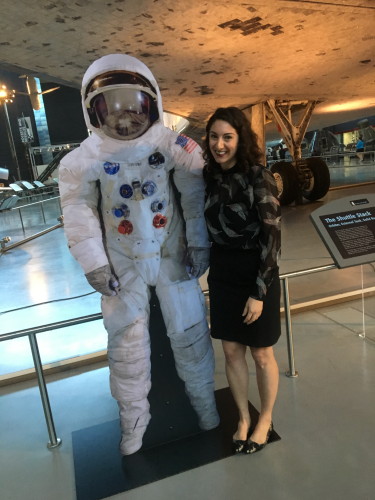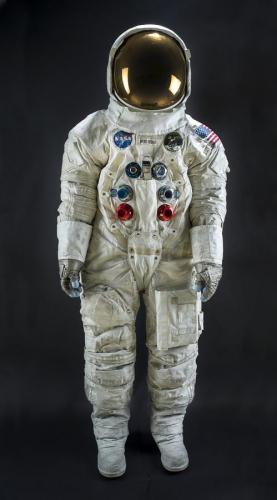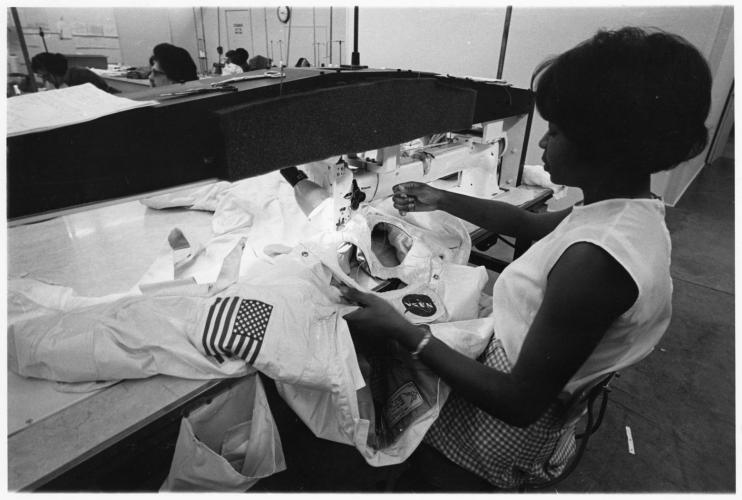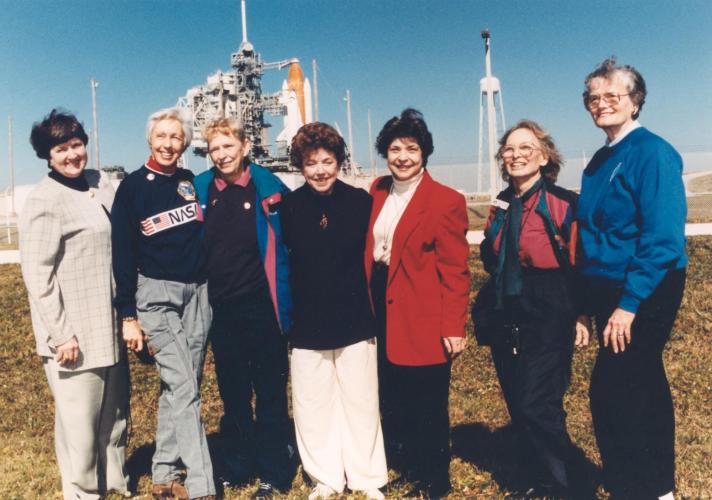
Dr. Emily Margolis at the Steven F. Udvar-Hazy Center in fall 2018. Photo by Lois Rosson.
Dr. Emily Margolis works as curator of American women's history in aviation, spaceflight, astronomy, and planetary science. She works at two Smithsonian sites: the National Air and Space Museum and the Center for Astrophysics | Harvard & Smithsonian in Cambridge, Massachusetts. Margolis works to interpret and expand museum collections to reflect women's contributions in air and space. We spoke with Margolis to ask her about her work at the Smithsonian.
Can you describe your job at the Smithsonian?
Every day is different. But the goal is the same: to ensure that women's stories are central to our understanding of the histories of aviation, spaceflight, astronomy, and planetary science. My work includes historical research, exhibition development, educational programming, and developing museum collections. I'm always learning something new from primary sources, books and articles, and from my colleagues.
Public talks and lectures are some of my favorite ways to connect people with Smithsonian content and collections. Because I joined the Smithsonian during the COVID-19 pandemic, I haven't had an opportunity to engage with our learners in person. But thanks to the Smithsonian's virtual programming, I've been able to share women's stories with people across the country! For example, last month a colleague and I presented the history of women at the Harvard College Observatory to a group in Chicago. I also enjoy using the museum's blog to amplify women's historical contributions to space and aviation and to talk about how women's history is relevant to aviation and spaceflight today.
What's the most exciting thing about your work?
I'm enjoying the collaboration and creativity I've experienced at the Smithsonian. I work with people who are really smart and passionate about understanding and sharing women's stories. We're making sure we share knowledge in creative ways. For the past few months I've been working with a group of colleagues at Air and Space and the Center for Astrophysics to amplify the stories of women in spaceflight and space sciences—past and present—in an upcoming virtual event for families, Sally's Night. I'm really excited about trying out some of our ideas this summer with the help of a Because of Her Story intern.
What is one favorite Smithsonian object that highlights women's STEM history?
I love challenging the way people see familiar objects. For example, Apollo spacesuits are some of the most famous garments in the world. When most people think about these iconic white spacesuits, they think about astronauts Neil Armstrong and Buzz Aldrin. They think about the men who explored the Moon's surface.

Pressure Suit (A7-L) worn by Neil Armstrong on Apollo 11 mission. National Air and Space Museum Collection, transferred from NASA.
Yet these spacesuits also represent a hidden history of women's contributions to the moon landing program. A cohort of women at International Latex Corporation in Dover, Delaware, constructed these spacesuits in close collaboration with engineers. Their expert knowledge of materials and construction methods was crucial to designing a suit that protected astronauts from the hazards of space without hindering their ability to move and work. This team of amazing women, both African American and white, included Iona Allen, Delema Austin, Doris Boisey, Julia Brown, Delema Comegys, Hazel Fellows, Joanne Thompson, Michelle Trice, Jeanne Wilson, and Delores Zeroles.

Hazel Fellows, seated, machine-sewing pieces of an Apollo A7L spacesuit on the production line at International Latex Corporation (ILC), Federica (Dover), Delaware; photograph released August 9, 1968. Smithsonian National Air and Space Museum.
NASA did not allow women to fly in space at this time, but the Apollo mission would have been impossible without women's labor and expertise. You can learn more about their work in the "Outer Space & Underwear" episode of Smithsonian's Sidedoor podcast.
What's one women's history story that you wish more people knew?
I am moved by the backstory of the 1995 launch of STS-63, the first U.S. space mission piloted by a woman. Astronauts have an opportunity to invite guests to view their launch from the VIP area at the Kennedy Space Center. Shuttle pilot Col. Eileen Collins' guest list for her historic mission included a group of aviators who paved the way: the First Lady Astronaut Trainees (FLATs).
Known popularly as the Mercury 13, the FLATs were accomplished pilots who volunteered to undergo individual physiological testing in 1959 with a NASA doctor in the hope of joining America's first class of astronauts. Unbeknownst to them, the space agency had not approved their participation and had no plans to include women in Project Mercury. NASA believed that military test pilots would make the best astronauts. The military did not allow women to become test pilots, so the astronaut eligibility requirements excluded women from participating.
Even though the space agency denied the FLATs an opportunity to fly in space, they proved that women were physically fit for spaceflight. Their dedication was undeniable. Many of them left their jobs to participate in the testing. After NASA closed the hatch on their pathway to space, they pushed for a Congressional hearing on the status of women in the space program.
Collins looked to the FLATs as role models and inspirations. Inviting them to her historic launch was a powerful expression of her gratitude, as well as a long overdue recognition of their importance to the history of spaceflight.
The photograph of FLATS at the STS-63 launch always makes me smile. It makes me think about the importance of role models in inspiring girls and young women in aviation and space careers. And the story of this launch also proves that is never too late to recognize the people history has forgotten.
What would you say to a student interested in learning more about women's history?
I think that the key is to be curious and to learn as much as you can. Follow your interests wherever they lead. I did not come to my work through history. I have a degree in physics. Everything that you learn impacts what you do.
You can also get involved in this research from home. You can volunteer with Project PHaEDRA to preserve history by transcribing astronomical research from women at the Harvard College Observatory. You don't need to be a historian or curator to engage with these stories or primary sources.
Related Posts
- Project PHaEDRA from the John G. Wolbach Library at the Center for Astrophysics | Harvard & Smithsonian
- Podcast Episode: Outer Space & Underwear(link is external)
- "A Seat in the Cockpit: Recognizing and Replacing Biases with Gender Inclusive Language" from our National Air and Space Museum
- NASM Story: Bee Falk's 100 Birthday from our National Air and Space Museum
The Smithsonian American Women's History Initiative, Because of Her Story, funds curators to research and share women's history at museums and centers across the Smithsonian. To support more women's history research, you can sign up for our newsletter to stay in touch. You can also donate to the Smithsonian American Women's History Initiative.
